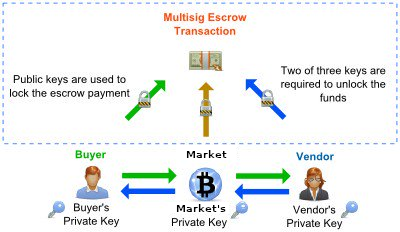Multisignature (Multisig) Markets
For the sake of keeping this simple we are going to be talking mostly about 2/3 Multisig. The number simply refers to the number of keys that are required. So what is multisig? Multisig stands for multi-signature. This means that multiple approvals (signatures) are needed before a transaction is confirmed.
Although already present in other industries, the concept was first applied to Bitcoin addresses in 2012, which led to the creation of multisig wallets and even pure multisig markets like for example Hansa, CGMC, Cannahome or Versus.
These wallets and payment systems function by adding one or more private keys to the wallet. This way, a transactions can only be confirmed by providing the 2 or more private keys.
How do they keep my coins safe?
The graphic below should help explain how multisig works. Lets run through a few examples of why multisig is useful.
- Increase Security – Hackers need all the participating keys to confirm a transaction and steal any coins.
- Company Transactions – for cryptocurrency businesses that work with multiple stakeholders, multisig wallets are optimal. It paves the way for decentralized organizations.
- Escrow Transactions – in this case, a multisig wallet can be used to lock the funds of a transaction between 2 parties until a 3rd trusted party (a Market) signs it with their private key.
Example: Lets say the buyer makes a purchase from a vendor. The market decides to exit scam or is seized. The coins are actually still safe! Even though the market will not sign, you and the vendor can sign releasing the funds to the vendor. (After you get your pack of course.)
As you can see, nobody can simply run off with your money. There always have to work two parties together to release the money (the buyer and the vendor, the DNM and the buyer or the DNM and the vendor).
If you have the choice, always use Multisig if possible, don’t give exit scams a chance!
To use multisig with specific DNM please look at their help section or wiki where you should find how to do it.

Multisig wallets best practices
As with all wallets, you should always back up your key(s) and write your mnemonic phrase on a piece of paper.
When working with multiple keys, it’s best to keep these keys in different locations and/or devices so they can be protected independently.
Keep in mind that when sharing a multisig wallet, all private key holders will have to take extra care of their private key. If the requirements for signing the transaction can’t be met, funds will become inaccessible to everyone.